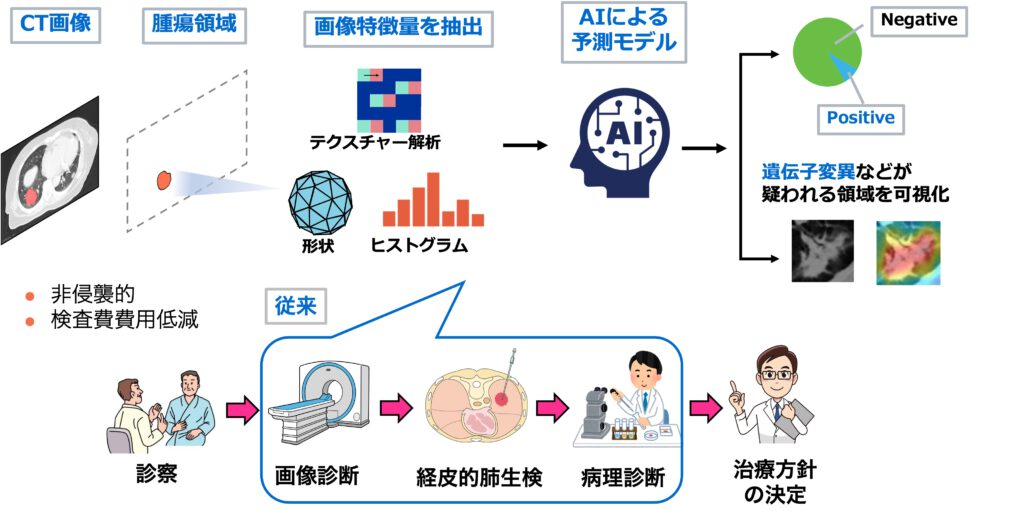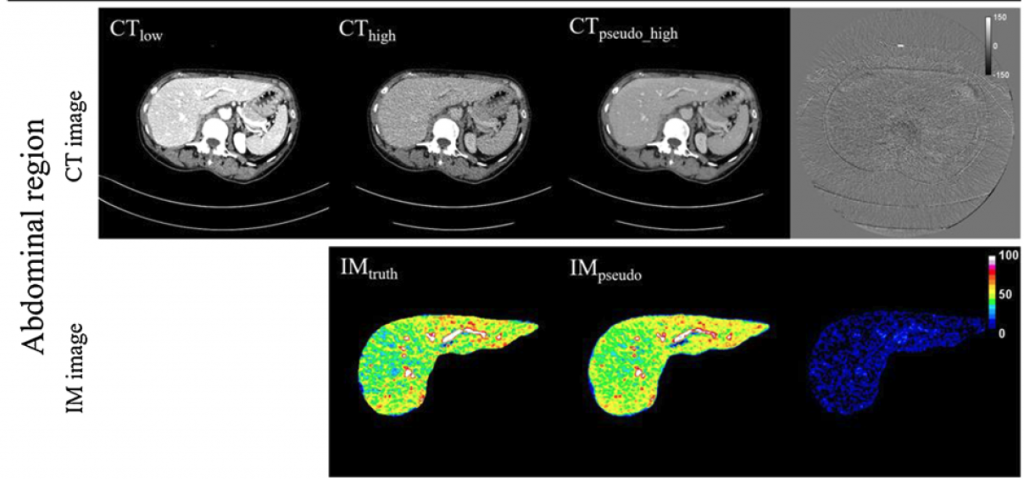Imaging Biopsy using AI

Tumors are heterogeneous and have a variety of characteristics. Medical imaging can obtain information about the entire tumor in a minimally invasive manner. In medical imaging, the entire tumor appears to be uniform in density, but statistical analysis of image features can extract information that is invisible to the human eye. By using this information, we are developing a mathematical model that can detect the characteristics of tumors and select the most effective treatment.
Development of automated radiotherapy planning by AI

Radiotherapy involves CT imaging, which is used to create a treatment plan that optimizes the beam direction and dose by outlining the target to be irradiated and the normal organs that are not to be irradiated. Currently, radiation oncologists and medical physicists spend a great deal of time on treatment planning. We are developing an AI-based automated radiation therapy planning system to make this process as efficient as possible.
Development of AI-based estimation method for pulmonary and hepatic blood flow imaging

The current CT images can obtain anatomical information such as the shape and morphology of organs, but it is difficult to obtain physiological and functional information. However, CT systems used in conventional diagnostics can only acquire images with one energy. We are developing an algorithm to obtain functional information about organs by using AI to generate images with two different energies.
Works
- 医学物理の視点から見るPrecision Medicineに向けた放射線治療
椎木 健裕, 田中 秀和.RadFan2020年12月号. - Prediction of EGFR Mutations, Subtypes, and Uncommon Mutations in Lung Adenocarcinoma Based On Machine Learning.
Kawazoe Y, Shiinoki T, Fujimoto K, Yuasa Y, Hirano T, Matsunaga K, Tanaka H. AAPM 2021, 63rd Annual Meeting. - Predicting PD-L1 Expression Level in Non-Small Cell Lung Cancer On Computed tomography Using Machine Learning.
T Shiinoki, K Fujimoto, Y Kawazoe, Y Yuasa, M Kajima, Y Manabe, T Hirano, K Matsunaga, H Tanaka.
AAPM 2021, 63rd Annual Meeting. - Comparison of the radiomics-based predictive models using machine learning and nomogram for epidermal growth factor receptor mutation status and subtypes in lung adenocarcinoma.
Yusuke Kawazoe, Takehiro Shiinoki, Koya Fujimoto, Yuki Yuasa, Tsunahiko Hirano, Kazuto Matsunaga, Hidekazu Tanaka.
Physical and engineering sciences in Medicine 2023年2月14日 - Investigation of the combination of intratumoral and peritumoral radiomic signatures for predicting epidermal growth factor receptor mutation in lung adenocarcinoma.
Yusuke Kawazoe, Takehiro Shiinoki, Koya Fujimoto, Yuki Yuasa, Tsunahiko Hirano, Kazuto Matsunaga, Hidekazu Tanaka.
Journal of Applied Clinical Medical Physics 2023年4月 - Predicting programmed death-ligand 1 expression level in non-small cell lung cancer using a combination of peritumoral and intratumoral radiomic features on computed tomography
Shiinoki T, Fujimoto K, Kawazoe K, Yuasa Y, Kajima M, Manabe Y, Ono T, Hirano T, Matsunaga K, Tanaka H.
Biomedical Physics & Engineering Express 8(2) 025008-025008 2022 March 1. - Single-energy CT-based perfusion imaging in thoracic and abdominal region based on the convolution neural network
Y. Yuasa, T. Shiinoki, K. Fujimoto, H. Tanaka.
International Journal of Computer Assisted Radiology and Surgery 15(S1) 1 – 214. - 深層学習を利用した仮想Dual energy CT画像とヨードマップの生成
湯淺勇紀, 椎木健裕, 藤本昂也, 田中秀和
第50回日本放射線技術学会秋季学術大会 2022年10月8日
